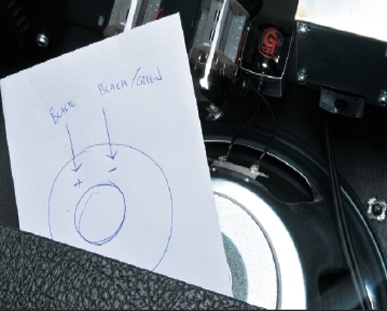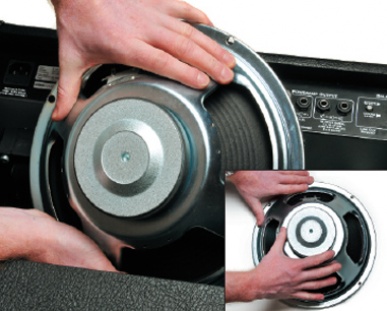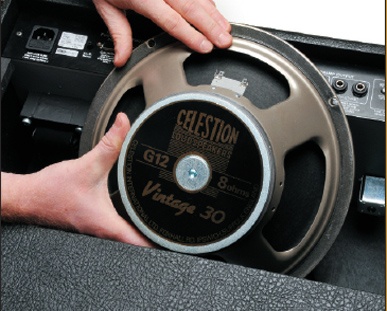UPGRADING: THE BASICS
1. POWER HANDLING
Speakers must be capable of taking at least as much power as the amp puts out, or you risk damaging them. So, for a single speaker amp or combo, pick an upgrade replacement with a power rating the same or higher than the amp’s power rating.
Minimum speaker power rating is half that of the amp for a twin speaker combo and for a cabinet with four speakers it will be a quarter of the amp’s maximum power output.
2. IMPEDANCE
Just as important as power rating is impedance – given in Ohms (written – Ω). If you use the wrong value, then the amp may be damaged. Ensure that your new upgrade speaker has the same impedance as the speaker it is replacing. So, if you’re taking out an 8Ω speaker, make sure the upgrade replacement is also rated 8Ω. (Note – some vintage speakers are rated at 15Ω, you can use these to replace a 16Ω without fear of damage.)
SAFETY FIRST: PLEASE READ BEFORE ATTEMPTING ANY WORK.
Ensure you have unplugged the amp from the mains electricity supply. This is because some amps, particularly those fitted with vacuum tubes, can retain dangerous voltages inside the chassis after they have been switched off and disconnected from the mains supply. Allow sufficient time for voltage discharge and tube cooling before following these steps.
Guitar speakers have large magnets which can affect audio visual equipment including, but not limited to, television screens and computer monitors. So pick your location carefully and make sure you have plenty of room in which to work.
ESSENTIAL TOOLS FOR YOUR UPGRADE
Here’s what you’ll need:
1. The combo amplifier/cabinet you’ll be working on and the Celestion upgrade speaker(s) you’re going to load into it.
2. A screwdriver to remove the back panel of the combo/cabinet.
3. The appropriate tool for the speaker bolts, for example a multi-wrench, allen key or screwdriver. Note that this will vary depending on the make of your combo/cabinet so be sure to check first.
4. Pen and paper for making a note of the existing wiring connections.
5. Pliers and electrical tape.
6. Wire cutters/strippers and soldering equipment (required for speakers with a ‘solder only’ tag panel)
SPEAKER UPGRADE STEP BY STEP:
STEP 1
Make sure the amp is disconnected from the mains supply and you have allowed sufficient time for the tubes (if fitted) to cool down and discharge any residual voltage if you have used it recently.
Check the terminals – are they ‘push on’ connectors or ‘solder only’?

STEP 2
Remove the back panel from your combo/cabinet (where fitted) and make a note of which colour wire goes to the + terminal of the speaker.

STEP 3
Disconnect the wires and get them safely out of the way using tape. Next, ensure the terminals are cleaned to achieve the best connection. Undo the bolts, then carefully remove the speaker(s) taking care not to damage the cone or anything inside your amp. Be careful – you may find the speaker is slightly stuck to the front baffle and comes free suddenly. Place the speaker face down on a flat surface.

STEP 4
Carefully insert and bolt in the upgrade speaker (take care when handling so as not to damage the cone). Finger tighten all bolts then tighten them with the appropriate tool, securing diagonally opposite bolts in sequence. Hand tight is fine, this will ensure that you don’t bend the speaker frame.
Connect the new speaker according to the wiring diagram you made earlier. Make sure all connections are solid and secure (you may need to tighten the clips using a pair of pliers.) If soldering, take precautions to ensure that hot solder cannot drip on to the speaker cone – it will cause damage. Re-check the wiring is correct!

STEP 6
Once you’re confident that the wiring is correct, plug in and turn on at low volume. Then, check for buzzes or anything untoward. When everything sounds OK, put the panels back and you’re ready to go.
BREAKING IN YOUR SPEAKER
Brand new speakers usually require a “breaking in period”. We recommend starting with a few minutes of low-level playing or background hum. Next, turn up the power amp volume to full, control the level with the preamp gain and play with a fat, clean tone. Have the bass and mid up full, and the treble set to at least half. On your guitar, use the middle pickup position (if your guitar has more than one pickup) and play for 10-15 minutes using lots of open chords, and chunky percussive playing. This will get the cone moving, and should excite all the cone modes and get everything to settle in nicely.

